Honda Civic Service Manual: Rear Brake Hose Removal and Installation (Natural Gas models)
4111A3 LEFT REAR
4111A4 RIGHT REAR
4111A5 LEFT AND RIGHT REAR

|
|
1.
|
Raise the vehicle on a lift, and make sure it is securely supported.
|
|
|
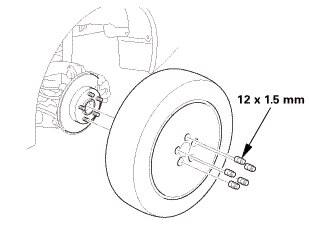
|
|
1.
|
Remove the rear wheel.
|
|
| 3. |
Rear Brake Hose (Natural Gas Model) |
|
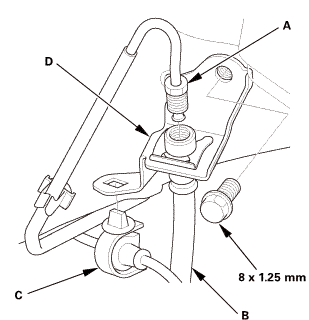
|

Do not spill brake fluid on the vehicle; it may damage the paint. If
brake fluid gets on the paint, wash it off immediately with water.
|
NOTE: After removal, plug the ends of the hoses and the joints
to prevent spilling brake fluid.
|
|
1.
|
Disconnect the brake line (A) from the brake hose (B).
|
|
2.
|
Remove the wheel speed sensor clip (C).
|
|
3.
|
Remove the brake hose bracket (D).
|
|
|
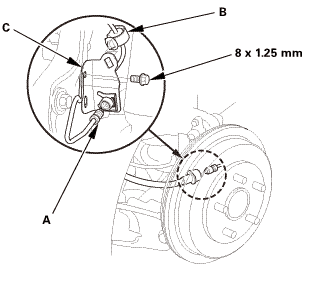
|
|
4.
|
Disconnect the brake line (A) from the brake hose.
|
|
5.
|
Remove the wheel speed sensor clip (B).
|
|
6.
|
Remove the brake hose bracket (C) with the brake hose.
|
|

| 1. |
Rear Brake Hose (Natural Gas Model) |
|
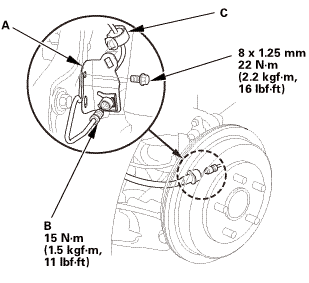 22nmnu 22nmnu
|

Do not spill brake fluid on the vehicle; it may damage the paint. If
brake fluid gets on the paint, wash it off immediately with water.
|
NOTE: After removal, plug the ends of the hoses and the joints
to prevent spilling brake fluid.
|
|
1.
|
Install the brake hose bracket (A) with the brake hose.
|
|
2.
|
Connect the brake line (B) to the brake hose.
|
|
3.
|
Install the wheel speed sensor clip (C).
|
|
|
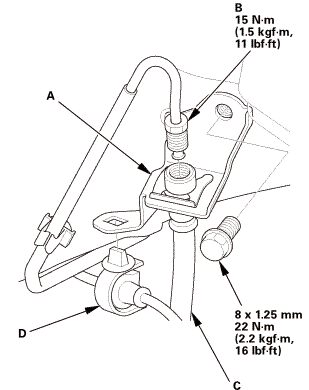
|
|
4.
|
Install the brake hose bracket (A).
|
|
5.
|
Connect the brake line (B) to the brake hose (C).
|
|
6.
|
Install the wheel speed sensor clip (D).
|
|
| 2. |
Brake System - Bleeding (Natural Gas Model) |
|
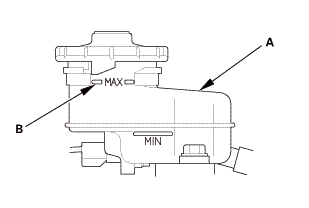
|

Do not spill brake fluid on the vehicle; it may damage the paint. If
brake fluid does contact the paint, wash it off immediately with water.
|

|
Do not reuse the drained fluid. Use only new Honda DOT
3 Brake Fluid from an unopened container. Using a non-Honda
brake fluid can cause corrosion and shorten the life of
the system.
|
|
|

|
Make sure no dirt or other foreign matter gets in the
brake fluid.
|
|
|

|
The reservoir connected to the master cylinder must be
at the MAX (upper) level mark at the start of the bleeding
procedure and checked after bleeding each wheel. Add fluid
as required.
|
|
|

|
There are three different methods used for bleeding brake
systems. The method shown here is the preferred manual method
for removing the air from the system. For pressure or vacuum
bleeding, refer to tool manufacturer's instructions included
with the tool.
|
|
|
1.
|
Make sure the brake fluid level in the reservoir tank (A) is
at the MAX (upper) level line (B).
|
|
|
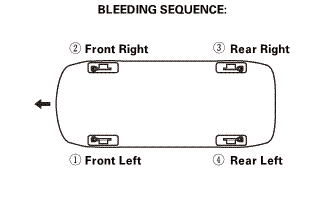 sznuzucz sznuzucz
|
|
2.
|
Start the bleeding at the driver's side of the front brake system.
|
|
NOTE: Bleed the calipers in the sequence shown.
|
|
|
Front
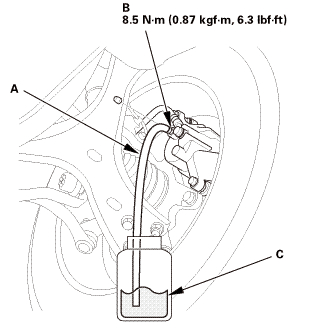 x.sm.x1imm x.sm.x1imm
Rear
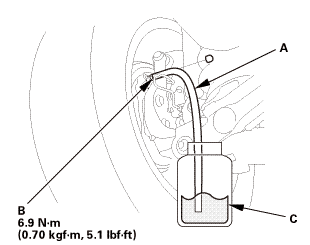
|
|
3.
|
Attach a length of clear drain tube (A) to the bleed screw (B).
|
|
4.
|
Submerge the other end of the drain tube into a clear plastic
catch bottle of brake fluid (C).
|
|
5.
|
Have an assistant slowly pump the brake pedal several times then
apply steady continuous pressure.
|
|
6.
|
Loosen the bleed screw slowly to bleed the fluid into the plastic
catch bottle. The brake pedal will travel toward the floor as the
fluid is bled from the system.
|
|
7.
|
When the brake pedal reaches the floor, have the assistant hold
the pedal in that position, then tighten the bleed screw. The brake
pedal can now be released.
|
|
8.
|
Check and refill the master cylinder reservoir tank to the MAX
(upper) level line. Be sure to reinstall the master cylinder reservoir
cap.
|
|
9.
|
Repeat steps 5 thru 8 until the brake fluid in the clear drain
tube appears fresh and there are no air bubbles in the fluid.
|
|
10.
|
Repeat this procedure for each brake in the bleeding sequence.
|
|
| 3. |
Brake Hose After Install - Check |
|
|
1.
|
Do the following checks:
|
|

|
Check the brake hose and line joint for leaks,
and tighten if necessary.
|
|
|

|
Check the brake hoses for interference and twisting.
|
|
|
|
|
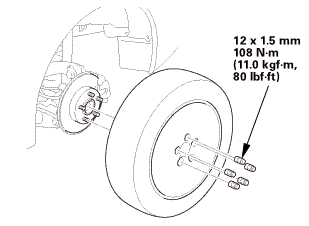 15mmumum 15mmumum
|
|
1.
|
Install the rear wheel.
|
|
NOTE: Before installing the wheel, clean the mating surfaces
between the brake disc or the brake drum and the inside of the wheel.
|
|


 Brakes
Brakes Disc Brakesъ
Disc Brakesъ




 22nmnu
22nmnu


 sznuzucz
sznuzucz x.sm.x1imm
x.sm.x1imm
 15mmumum
15mmumum